Smoking and Circulation
While most people equate smoking deaths to cancer and lung disease, in fact many more people will die from circulatory conditions from smoking than die from cancer or other lung diseases. Also, in general, they will die at much younger ages from these problems.
We would have many more lung cancers than we do if smokers could live long enough to get them. When many people with fatal heart attacks or strokes are autopsied, there are often precancerous lesions found that indicate that if these people had a few more years to live they would have eventually succumbed to these smoking induced diseases.
As for heart and other circulatory diseases, the two chemicals in cigarettes that stand out as the biggest problems are nicotine and carbon monoxide. Nicotine, besides being addictive, has very powerful effects on arteries throughout the body.
Nicotine is a stimulant, speeding up the heart by about 20 beats per minute with every cigarette, it raises blood pressure, is a vasoconstrictor - which means it makes arteries all over the body become smaller making it harder for the heart to pump through the constricted arteries - and it causes the body to release its stores of fat and cholesterol into the blood.
The heart has to work harder to overcome all of these effects. To work harder the heart, like every other muscle in the body, needs extra amounts of oxygen for the additional workload. The oxygen has to be transported through the blood. But carbon monoxide from tobacco smoke literally poisons the oxygen carrying capacity of the blood.
So this results in the heart having to work harder to get more blood to itself to work harder, because it's working harder. This is a circle. A vicious and deadly circle when it comes down to it.
Below we see the cross section of a normal artery. Usually we have nice big openings in the artery to carry oxygen as well as all other nutrients to all the tissues of the body.

If you compare this artery to the one below...

... you can see the blood clotted, blocking the blood flow to whatever organ or tissue this artery was leading to. Without being able to get circulation, that tissue will literally suffocate in a matter of minutes and basically be left as useless tissue. Sometimes the artery involved is a coronary artery, one that supplies the heart with the blood it needs to function.
Below is a picture of a coronary artery attached to the heart.
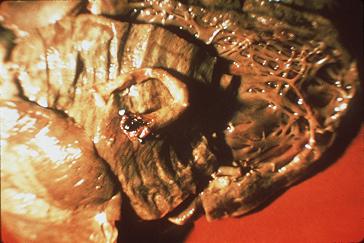
If we look at a close up view of the artery...
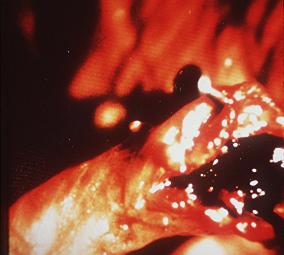
... we see the blood clotted and blood flow to the section of the heart that this artery was supplying was cut off. What will result is that a portion of the heart muscle that was supposed to get that blood flow suffocates and dies within a matter of minutes.
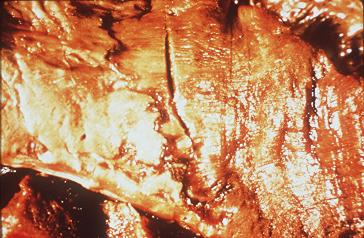
Above we see infarcted (dead) heart muscle (myocardial infarction). The tissue is literally brittle as illustrated by the cracking effect. Instead of being able to pump blood, this area whole section of muscle is no longer able to be utilized for its life sustaining function.
Again, smokers get this much more often because of the effects of nicotine and carbon monoxide. Nicotine having all the direct effects on the heart itself, carbon monoxide robbing the oxygen supply, and both chemicals increasing clotting as well as clogging factors in the blood.
If the section of the heart affected was larger enough the smoker would die from the first attack. Often smaller areas are affected and the patient can survive but has lost that specific section of the heart and may have permanent impairments from the now limited supply of heart tissue.
Cigarette smoking increases risks of blood clots significantly. If the blood clots in an artery and blood can no longer get through, the tissue that is supposed to be supplied with blood has lost the source of its oxygen and nutrients and dies in minutes. But clots are not the only way these arteries can be blocked. Another way is by clogs.
As opposed to clots where the blood actually coagulates and becomes an obstruction, clogs are where deposits of fat gradually build up. In the first picture below you can literally see the start of a artery getting a fat buildup.
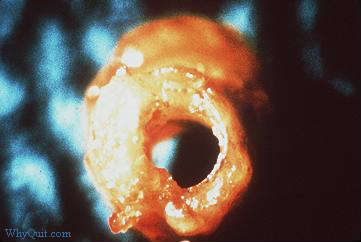
Over time, this opening can get narrower and blood flow gets more and more impeded. This of course adds to the workload of the heart to pump through smaller arteries with increased resistance. But this clogging does not only happen to the coronary arteries, it literally happens all over the body.
Remember, nicotine is not only a vasoconstrictor, making arteries go into constrictions every time it is administered, but it also causes the body to release its own stores of fat and cholesterol. Besides this, carbon monoxidehas an effect that makes the fat stick to the arteries. The reason is carbon monoxide lowers the oxygen level of the blood (hypoxia) and hypoxia seems to have an effect making fat stick to artery walls.
Eventually over time arteries can become totally blocked with fat as seen in the slide below.

As in the case with a clot, blood cannot get through and the body part that was contingent on that blood supply for survival is lost. If this artery lead to your heart as in the case of the clotted coronary arteries above, the result would be a heart attack with a loss of heart muscle that if large enough would be fatal. But the heart is not the only organ affected this way. Another common site of problems are the arteries leading to the brain. Below is a picture of the base of a health human brain.

The arteries to the brain are very small here and clear, very difficult to see in fact. The arrows are pointing them out. To see them clearer here is a close up shot of these arteries...

Again note, these arteries are very thin and clear. Smoking increases the fat deposits to these arteries so often, instead of looking like this, they can look like the slide below...

With the fat build up the arteries are much easier to see. But this build up if complete cuts off circulation to your brain and as is the case with the heart, the part of the brain that no longer gets circulation dies. This is what happens in the case of a stroke.
Circulation gets cut off from the brain either through a clog or a blood clot. The section of the brain that gets cut off suffocates and dies. If this part of your brain controlled speech, you will not talk anymore, if it controlled some form of motor function, these abilities will be lost and leave the patient impaired or crippled. If the section of the brain affected controlled some life sustaining function, the patient will die, again, within minutes of when the circulation cut off is complete.
The clogging and clotting effects of nicotine and carbon monoxide are the primary reasons why smokers are at such a higher risk of this condition. But this clogging/clotting effect is not limited to just major organs like the heart or brain. These chemicals affect arteries throughout the entire body. These affects may not be as deadly as cutting off circulation to the heart or brain, but in a real way they can show the true potential of the grip of the nicotine addiction.
Peripheral circulation, arteries going to the extremities are also highly susceptible to the vasoconstrictor effects of nicotine as well as the increase of clots and clogging risks posed by smoking. Smoking is a primary cause of much of the peripheral vascular disease seen as well as a powerful aggravating factor for people who have other preexisting conditions causing circulation problems to the extremities.
One condition though stands out as being truly unique and in many ways, demonstrates the real addictive nature of nicotine better than any other cause. The condition is known as Buerger's Disease (thromboangiitis obliterans.) Buerger's Disease is a condition where there is a complete cutoff of circulation to the finger or toes, resulting in gangrene.
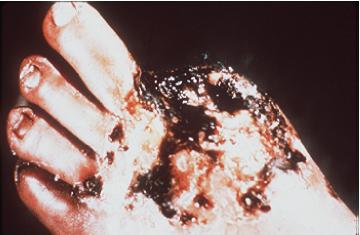
Once gangrene occurs the only course of action is to amputate the affected area.
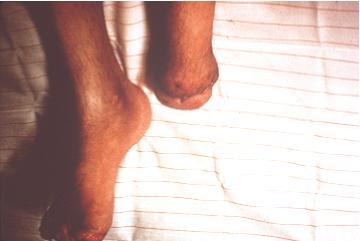
The most common age bracket that this disease strikes is in people between the ages of 20 to 40, normally young to get circulation problems that result in amputations. While it is much more common in men, women are affected to.
What makes Buerger's Disease unique is that it is a disease that is basically exclusive to smokers. There are almost no documented cases of this disease happening in a non-smoker. Smoking is the primary etiologic factor. This is a rare disease, but noteworthy because of this unique nature of happening only in smokers.
If a smoker gets lung cancer, the person and other people can sometimes think, "well non-smokers sometimes get lung cancer too, maybe cigarettes didn't cause it." Same thing with heart attacks or strokes, non-smokers get them too, smokers just get them much more often. But again a certain level of denial can be exhibited and there is no way to conclusively prove that cigarette did it.
But Buerger's Disease, having no other known cause and basically never happening in non-smokers does not lend itself to such denials. When a doctor determines he or she is dealing with a Buerger's Disease patient, a basic ultimatum is going to be delivered - quit smoking or lose your limb - your choice! If we were dealing with simply a "bad habit," how many people given such an ultimatum and knowing it is true would continue doing the particular behavior given such consequences?
While Buerger's Disease is much more common in men, I have personally had two women who were Buerger's Disease patients in my clinics. My first actual encounter with a Buerger's Disease patient was with a woman who was 38 year old when I met her, which was about 24 years ago.
Three years before I met her, at the age of 35 she was diagnosed with Buerger's Disease. This is actually relatively late to first be diagnosed. Her doctor had told her she had to quit smoking, but she did not comply and within a few months she had her right leg amputated. The circulation in her left leg was also badly affected, and after the hospitalization from the amputation she did quit smoking and had no further circulatory complications for the next three years.
Then one night at a party, a friend offered her a cigarette. She figured that since she had been off cigarettes for so long, she now had control over her dependency. If she liked the cigarette, she would smoke one or two a day. If she didn't like the cigarette, she just wouldn't smoke anymore.
Well, she took the cigarette. She didn't particularly like the cigarette, but the next day she was up to her old level of consumption. Four days later she lost circulation in her left leg. She knew the reason. After three years with no problem and only four days after going back to smoking her circulation was affected. Her doctor told her that if she did not quit immediately, she would probably lose her other leg.
This is when I met her. She enrolled in a smoking clinic that week and quit smoking. Almost immediately her circulation improved. The doctor took her off anti-coagulant drugs and vasodilators he had put her on a few weeks earlier to try to slow up the process even though they were highly ineffective at stopping the likelihood of gangrene and amputation. But once she quit smoking she no longer needed them. Soon, her circulation was back to normal.
Nine months later, I called to ask her to serve on a panel. At that time, she sluggishly replied, "I can't come. I have been in the hospital the last two months." When I asked what had happened, she hesitantly replied, "I had my toes amputated." She had gone back to smoking. She tried one because she just couldn't believe she would get hooked again. She was wrong. She lost circulation, had her toes removed and eventually had her leg amputated.
I have had other clinic participants with similar experiences, being told to quit smoking or lose limbs who did not quit smoking. The reason I talk about this particular woman again and again is about a year after she had the second amputation, she came back into a clinic I was conducting and told me she had quit again and was now off about 9 months.
I told her I was surprised, I thought she had permanently lost control. After all, she had her leg removed, the toes from her other foot, and eventually her second leg. When I confronted her with that information she replied, "The doctor finally convinced me. He said, 'You might as well keep on smoking, I'll just take your arms off next.'"
That scared her into quitting smoking. Her next comment to me was unbelievable. She looked me straight in the face, dead seriously, and said "I DIDN'T NEED A HOUSE TO FALL ON ME TO TELL ME TO QUIT SMOKING."
I had periodic contact for the next 15 years at which time she moved away. She was fine over that whole time period. Whenever I brought up that conversation, we both found ourselves amazed that she could ever have made such an irrational statement.
She happened to be a very rational, bright and inspirational individual. She would get around on wooden legs, socializes, and even occasionally would sing and dance on stage. Once she had broken free of the drug's effects and the smoker's psyche, she knew she could do anything.
Frequently, I would encounter people who quit smoking on their own. When I ask how they did it, they tell me of this marvelous lady they met who told of how she used to be hooked on smoking. Hooked so bad, in fact, that she had her legs amputated from a smoking related illness. It usually turns out to be the same person. By spreading her story, she offers inspiration and hope to countless smokers to break the addiction before the addiction breaks them.
Her story represents the real power of the addiction. She could not deny any where along the way smoking wasn't the cause. Not only would every doctor and all the research she could do pinpoint smoking as what was causing her problem, but she had quit, was fine, relapsed and within days lost her circulation - twice! The second time she actually lost her toes and her foot and then her lower leg. There was absolutely no way she could deny the cause and yet it took another 9 months for her to quit again.
Her continued smoking and ease of relapsing shows nicotine dependency at its worst. This overpowering nature of nicotine should not be lost on anyone here.
You probably don't have a condition that is obvious as to force you to make a decision almost immediately upon relapse. In many ways this is worse, for cigarettes are quietly and insidiously destroying you, sometimes with little warning, or at least ones you will acknowledge. The first symptom to many circulatory diseases caused by smoking is sudden death. You may get no second chance.
Once you have a quit smoking, do everything in your power to make it last. You don't know that you will have the desire, strength or worst of all, the opportunity to quit next time. A tragic and fatal disease may get you first. Always consider the full danger of smoking and power of the addiction and your likely choice will be to - NEVER TAKE ANOTHER PUFF!
Share this article
Watch Joel's heart and circulatory diseases video
Next Cost of Smoking Lesson

